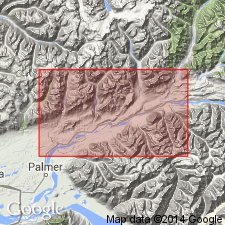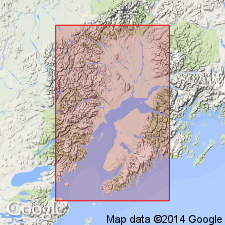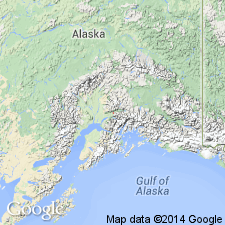
- Usage in publication:
-
- Chickaloon formation*
- Modifications:
-
- Original reference
- Biostratigraphic dating
- Dominant lithology:
-
- Shale
- Sandstone
- Coal
- AAPG geologic province:
-
- Alaska Southern region
Summary:
Pg. 15, 42-52, map. Chickaloon formation. Rather monotonous succession of shales and sandstones, the shales predominating and being gray to drab, rather soft, poorly bedded; the sandstones are yellowish, rather soft, of diverse grain. Thickness appears to be at least 2,000 feet. Flora shows it to be certainly Tertiary and probably Eocene. Rests on 2,000+/- feet of arkose, conglomerate, and shale of Eocene age. Underlies Eska conglomerate (Miocene?).
Covers greater part of valley of Chickaloon River south of Castle Mountain, or south of point about 5 mi above mouth of the river, Cook Inlet region, central southern AK.
[GNC remark (ca. 1936, US geologic names lexicon, USGS Bull. 896, p. 425): The flora of this formation is now regarded as Eocene.]
Source: US geologic names lexicon (USGS Bull. 896, p. 425).

- Usage in publication:
-
- Chickaloon Formation*
- Modifications:
-
- Age modified
- Biostratigraphic dating
- Overview
- AAPG geologic province:
-
- Alaska Southern region
Summary:
Consists of interbedded claystone, siltstone, feldspathic sandstone, conglomerate, and many beds of bituminous coal. Is at least 5000 ft thick. Unconformably overlies Matanuska Formation. Conformably underlies Wishbone Formation. Chickaloon appears to be entirely Paleocene age based on flora which are compared to flora of Fort Union Formation (whose age is established by fossil mammals).
Source: GNU records (USGS DDS-6; Menlo GNULEX).

- Usage in publication:
-
- Chickaloon Formation*
- Modifications:
-
- Age modified
- Geochronologic dating
- AAPG geologic province:
-
- Alaska Southern region
Summary:
Age is Paleocene and early Eocene. K-Ar age of 55.1 +/-1.7 Ma and zircon fission-track age of 53.1 +/-1.3 Ma from volcanic ash partings in Chickaloon establish the Paleocene-Eocene boundary in upper part of Chickaloon Formation (based on Paleogene time scale of Hardenbol and Berggren (1978) which gives boundary at 55 +/-1 Ma).
Source: GNU records (USGS DDS-6; Menlo GNULEX).
For more information, please contact Nancy Stamm, Geologic Names Committee Secretary.
Asterisk (*) indicates published by U.S. Geological Survey authors.
"No current usage" (†) implies that a name has been abandoned or has fallen into disuse. Former usage and, if known, replacement name given in parentheses ( ).
Slash (/) indicates name conflicts with nomenclatural guidelines (CSN, 1933; ACSN, 1961, 1970; NACSN, 1983, 2005, 2021). May be explained within brackets ([ ]).

